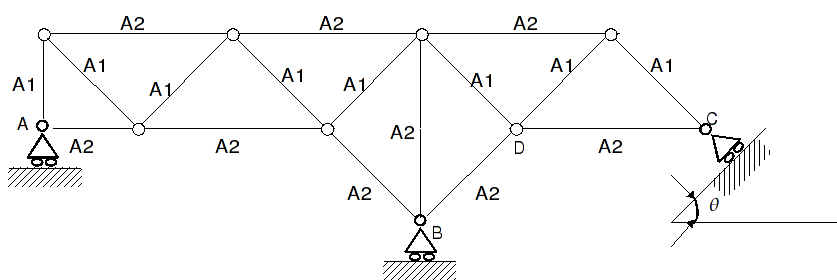3. Modeling A#
3.1. Characteristics of modeling#
Type of modeling used: element BARRE.

3.2. Characteristics of the mesh#
\(\theta =30°\), \(\mathrm{A1}=1.41E–\mathrm{03 }{m}^{2}\)., \(\mathrm{A2}=2.82E–\mathrm{03 }{m}^{2}\).
3.3. Tested sizes and results#
Identification |
Reference |
Aster |
% difference |
Load: thermal expansion |
|||
Option: “EFGE_ELNO” |
|||
Knit \(\mathrm{M10}\), Knot: \(B\), Cmp: \(N\) |
1.29541 E+04 |
0.063 |
|
Knit \(\mathrm{M16}\), Knot: \(C\), Cmp: \(N\) |
4285.2 |
4.28926 E+03 |
0.095 |
Knit \(\mathrm{M17}\), Knot: \(C\), Cmp: \(N\) |
—10189. |
—1.02076 E+04 |
0.183 |
Load: point forces |
|||
Option: “DEPL” |
|||
Node: \(E\), Cmp: \(\mathrm{DY}\) |
—1.0566 E—02 |
—1.05800 E—02 |
0.133 |
Option: “EFGE_ELNO” |
|||
Knit \(\mathrm{M10}\), Knot: \(B\), Cmp: \(N\) |
—87137. |
—8.71128 E+04 |
—0.028 |
Knit \(\mathrm{M16}\), Knot: \(C\), Cmp: \(N\) |
2.41596 E+04 |
0.007 |
|
Knit \(\mathrm{M17}\), Knot: \(C\), Cmp: \(N\) |
—57524. |
—5.74954 E+04 |
—0.050 |
Charge: imposed trips |
|||
Option: “EFGE_ELNO” |
|||
Knit \(\mathrm{M10}\), Knot: \(B\), Cmp: \(N\) |
65979.1 |
6.59757 E+04 |
—0.005 |
Knit \(\mathrm{M16}\), Knot: \(C\), Cmp: \(N\) |
21839.1 |
2.18453 E+04 |
0.029 |
Knit \(\mathrm{M17}\), Knot: \(C\), Cmp: \(N\) |
—51925.6 |
—5.19877 E+04 |
0.120 |
Charge: accumulation of the 3 requests |
|||
Option: “EFGE_ELNO” |
|||
Knit \(\mathrm{M10}\), Knot: \(B\), Cmp: \(N\) |
—8211.2 |
—8.18302 E+03 |
—0.343 |
Knit \(\mathrm{M16}\), Knot: \(C\), Cmp: \(N\) |
50282 |
5.02942 E+04 |
0.024 |
Knit \(\mathrm{M17}\), Knot: \(C\), Cmp: \(N\) |
—1.1964 E+05 |
—1.19691 E+05 |
0.043 |
3.4. notes#
No bending strain is involved in the calculation of the solution.